Our Patients
Stories that inspire
Although nano-rare patients may be one in the world, they are part of our nano-rare community. Meet these nano-rare patients and learn about their unique diagnostic journeys.
Patient stories












































































































































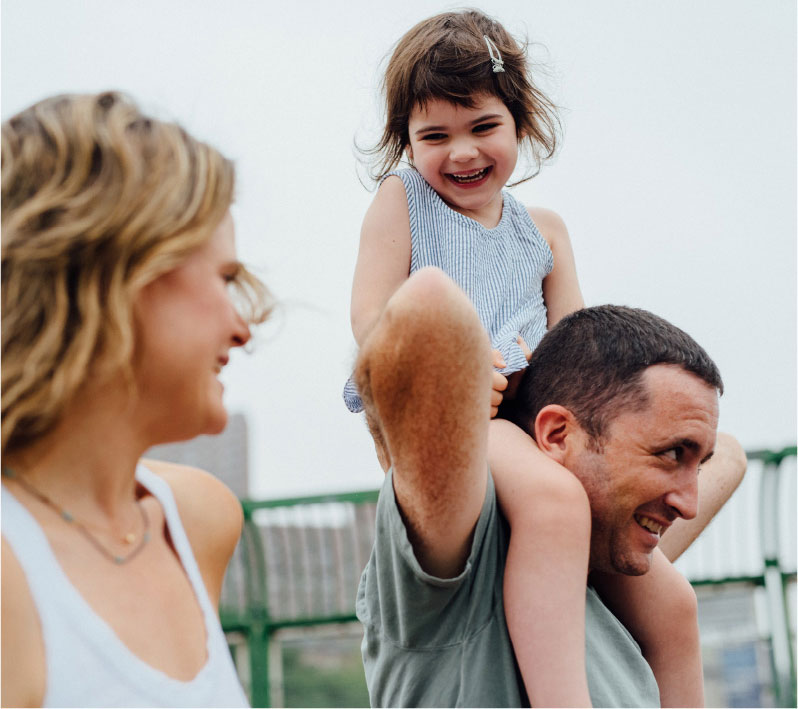
UPDATE: Susannah received her first dose of a personalized experimental ASO medicine in October 2022. This medicine was discovered and developed for her unique gene mutation.
Antisense oligonucleotide therapy in an individual with KIF1A-associated neurological disorder
Meet Susannah
Shortly after Susannah was born, her parents noticed abnormalities in her leg movement, signaling something was extremely wrong. Their sweet little girl was later diagnosed with a frightening and debilitating nano-rare disease, KIF1A, resulting in a significant movement disorder, seizures, and speech and vision challenges. She also experiences an inescapable neuropathy in both her hands and feet that cause deep and painful burning sensations.
However, nothing can stop Susannah from shining a light on the world with her beautiful smile, positive outlook, and sincere devotion to loved ones. Just when life starts to get those around her down, she wraps her strong arms around them for a “Ginormous Suz Hug.” Those hugs are perfect. She inspires her family to live in the moment, get out of their comfort zone, sing at the top of their lungs and laugh until it hurts.
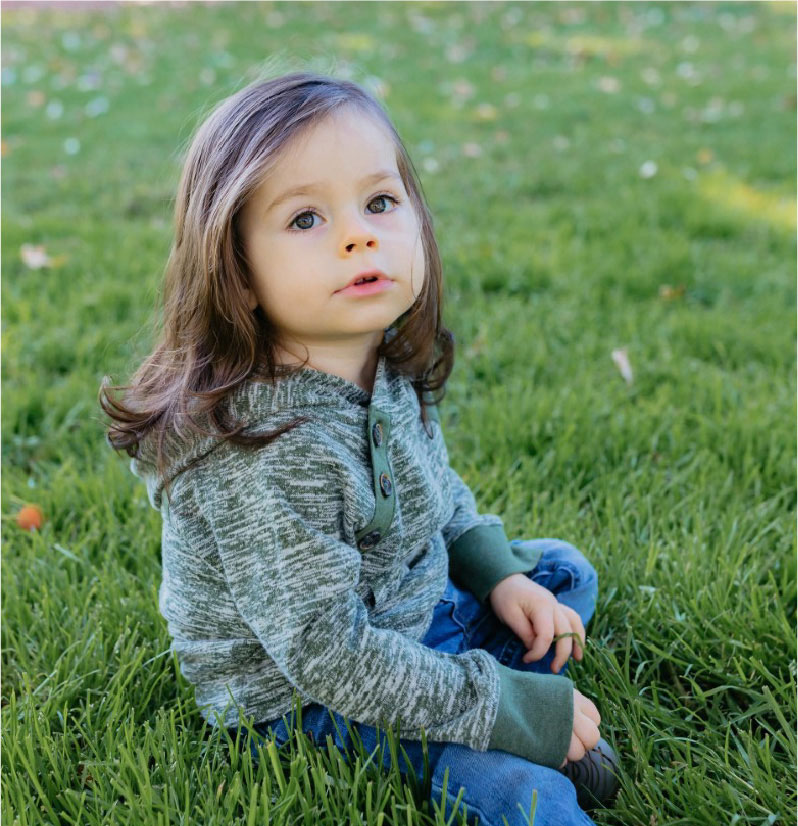
Meet Tristan
Tristan was born after a normal pregnancy in 2019. From the minute his parents saw him, they thought something looked a little off about his eyes. As none of the doctors or nurses mentioned anything, they took him home and assumed he was fine. At four months old, they started noticing some slight delays and got him into early-intervention therapies, assuming he would “catch up,” as many children do. After a year of multiple rounds of testing, they got the devastating diagnosis: a nano-rare KCNH1 genetic mutation characterized by epilepsy, profound intellectual disability, and severe speech and movement disorders.A month after Tristan was diagnosed, he had his first utterly terrifying seizure. Tristan can have seizures as a result of even the mildest illness. When he seizes, he completely stops breathing and it takes him 1-2 weeks to recover each time. The biggest impact of Tristan’s mutation is on his cognitive abilities. He can’t so much as point to something to show what he wants. His cognition was rated in the <.1 percentile with impairment so severe that many therapists have no clue how to help him.
His parents’ biggest dream is for their family to be free of the constant fear of seizures, for Tristan to be able to share what’s going on in his little head, and for him to be able to enjoy activities with his brothers rather than just watching them!
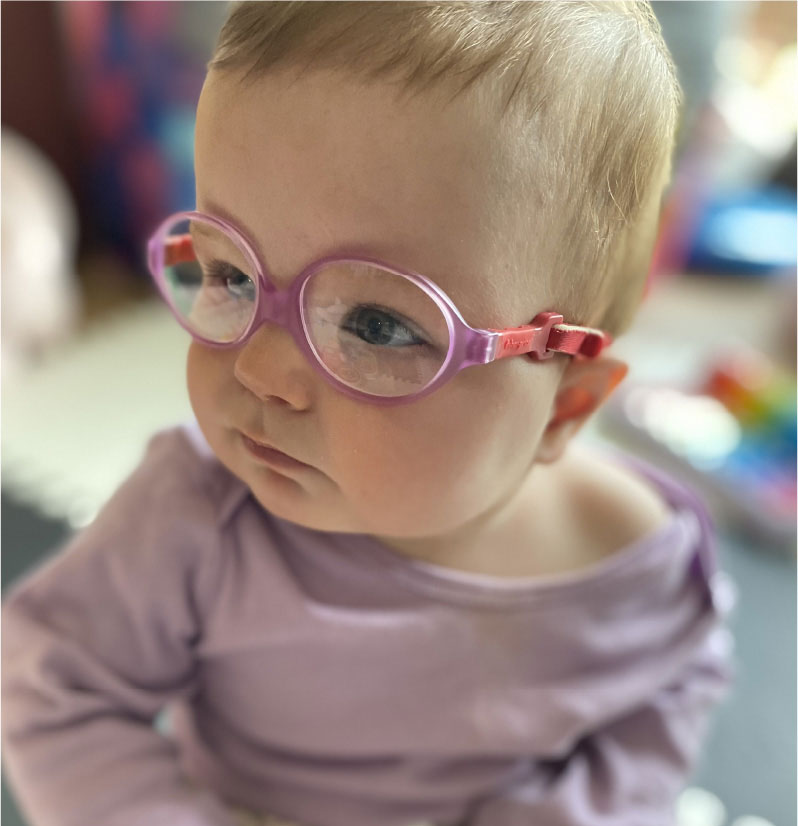
“Thanks to Lena’s acceptance into n-Lorem, hope became tangible, tangible like never before and this hope can be counted in months rather than decades. While the most experienced ASO team in the world is working on personalized treatment for Lena, we’ve also decided to add something from ourselves – we’ve opened PACS2 Research Foundation (www.pacs2research.org) with aim to understand mechanism of action of this disease and contribute to the rare-disease community.”
Meet Lena
Up until 3 months of age, Lena developed normally. She was a little bit weaker than average but being twin and premature baby was a simple explanation for this. Her family’s life changed irrevocably on the day of Christmas, 2021. Lena woke up and, out of nowhere, had her first seizure. Three days later, she was in the hospital with status epilepticus and experienced 30 grand mal seizures in 48 hours…
Despite being devastated, her parents acted fast and in Feb 2022 (thanks to DNA sequencing) she was diagnosed with a single-point mutation in the PACS2 gene, a nano-rare disease with only dozens of cases diagnosed worldwide. She struggles with epilepsy, intellectual disability, global development delay and autism spectrum.
Lena has committed countless hours towards various therapies helping her to improve on motor, social and speech skills. Despite them, she is behind in many areas, which is especially heart-breaking for her parents as they observe how she cannot keep up with her twin sister’s development and crazy ideas.
When Lena’s parents found out about n-Lorem, they knew it would be an amazing opportunity for their daughter. Putting the petal to the metal, a few weeks after Lena’s diagnosis, her application was submitted to n-Lorem by the amazing Dr. Wendy Chung from Columbia University.
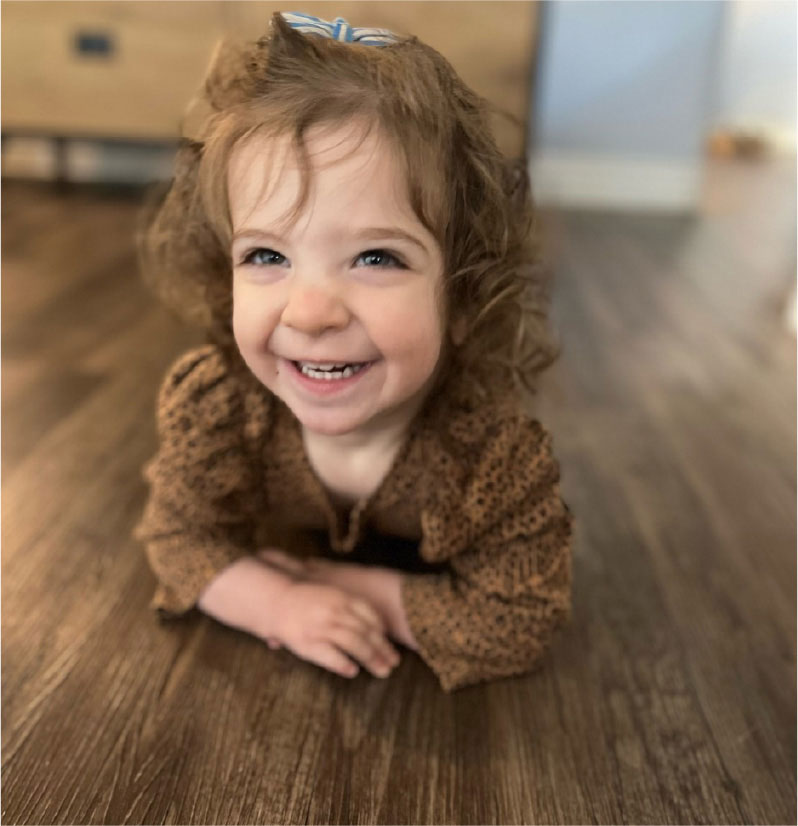
Meet Sloane
While this is an incredibly challenging disorder, Sloane keeps everyone around her motivated and reminds them it’s about focusing on the now and celebrating the little wins, like recently learning to army crawl!
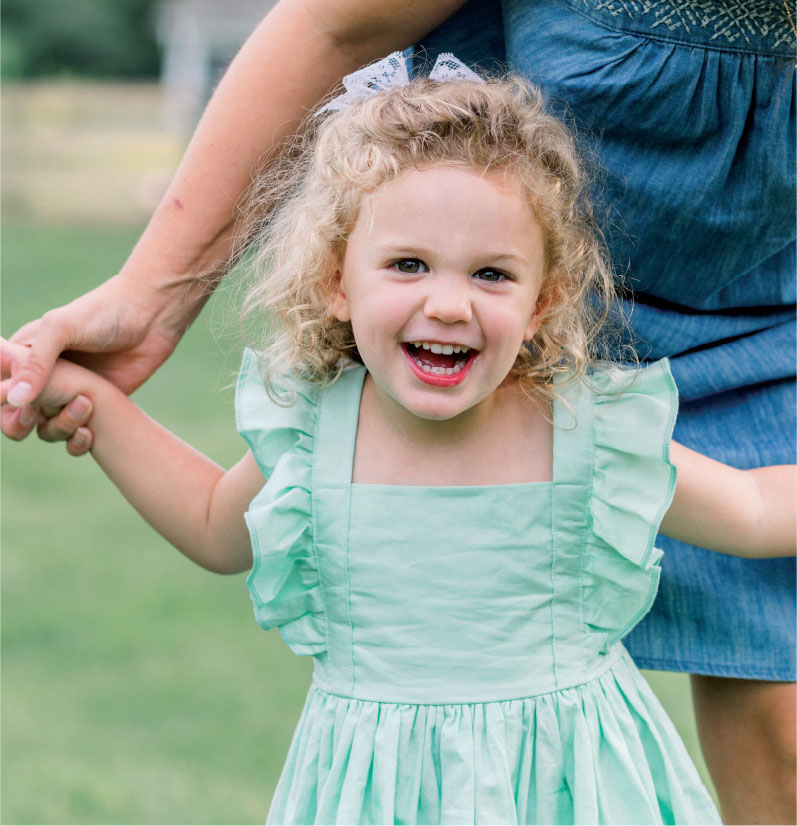
Meet Ireland
When Ireland was 6 months old, she had her first generalized tonic clonic seizure, which led to an epilepsy diagnosis and genetic testing. The testing revealed a CACNA1A pathogenic variant, of which the effects have been absolutely devastating. Her parents were told that no targeted treatment options were available as she was the only known case of her unique variant, classifying her as nano-rare.
Ireland presents with cerebellar ataxia, a convulsive seizure disorder with status epilepticus, developmental delays, apraxia of speech, hemiplegic migraine, and autism. Her biggest challenge is poor seizure control, despite trying a long list of AEDs, the Modified Atkins Diet, Epidiolex (CBD) and a VNS (vagus nerve stimulator) device. Ireland’s seizures are severe, never stopping without multiple rescue medications. She can completely stop breathing, requiring immediate airway intervention and support. Ireland has been intubated 9 times for status epilepticus. Between recovering from massive neurological events and frequent medication changes, Ireland often feels pretty terrible. Her family dreams of the precious day that personalized experimental ASO medicine allows her to take steps towards returning to her sweet, happy feel-good self.
Ireland works very hard in PT, OT, Speech and ABA therapies. She is able to walk, hop, climb, feed herself, and speak in single words. She continues to make developmental progress, despite setbacks caused by seizures. She has a supportive village of family and friends who dream of a treatment to reduce the heavy burden caused by her genetic variant.
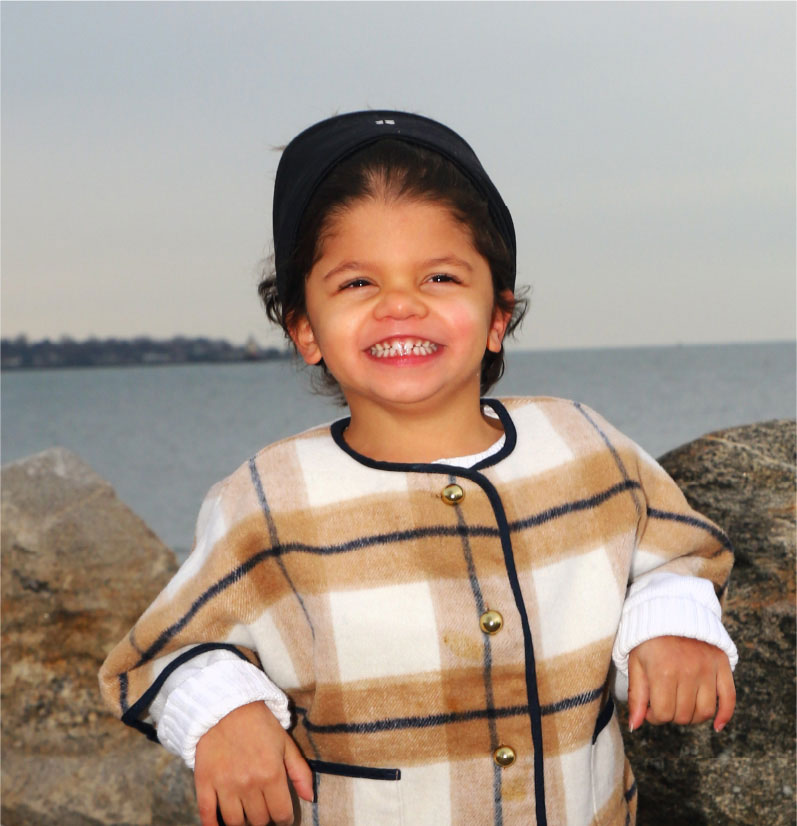
“We know that Alya has so much unlocked potential with plenty to give to the world. We are deeply grateful to the n-Lorem Foundation for giving us the hope that there is a possibility, with an ASO treatment, to see Alya thrive in her life and achieve her full potential. We hope that one day Alya’s seizures are suppressed, that she’ll speak to us with real words, and that she will become independent, especially when we are no longer alive to care for her. We also have a lot of hope that Alya’s treatment will be successful, and she will be a pioneer in helping to bring this potentially life-changing treatment not only to other individuals with PACS1 syndrome but to the broader rare disease community, which is in desperate need of such treatments.”
Meet Alya
When Alya was 5 weeks old, she suddenly started to have uncontrollable seizures, one after another, and was rushed to an emergency room where she was hospitalized for a week. Initially, MRIs and genetic testing didn’t reveal anything. So, her family felt they were forced to hope that things would resolve themselves and that she would live a normal life. Her family continued to fight for a diagnosis and, at age 3, a full-exome sequencing test revealed a nano-rare disease called PACS1 syndrome. The family was told that there were no treatment options available and to do their best to manage the symptoms.
Alya was significantly delayed in everything: she smiled late, she walked late, and still, at age 9, has only 3 spoken words – for her 3 favorite people, “mama”, “papa”, and “Krish”. She continues to have significant intellectual disability, motor delays, epilepsy (even with a ketogenic diet and multiple medications), is not toilet trained, cannot feed herself, and as it stands now, she will require life-long care in the most basic areas of life (such as feeding and safety). She has been through thousands of hours of therapies, 19 electroencephalograms (EEGs) since she was born, and countless procedures. Yet, she is smiling.
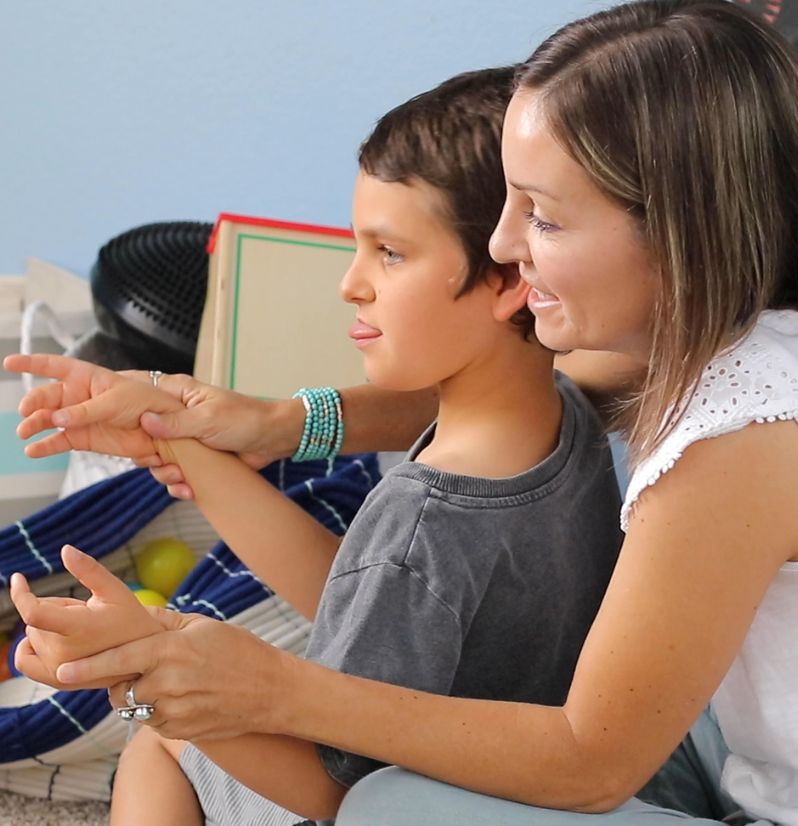
“The most sincere, heartfelt thank you to all of the scientists, doctors, researchers, companies and donors that have turned a hopeless situation into so much possibility and potential for Connor, his brothers and me. And it is all happening now – in my son’s lifetime – and for that, I am eternally grateful.”
Meet Connor D.
After whole exome sequencing, he was diagnosed with a mutation in the SCN2A gene, which is the cause of all his debilitating symptoms and endless suffering. His family was told, “We don’t know much about this disease, and we have nothing new to offer you. In 100 years from now, we will have learned to silence the mutated gene, but not in your son’s lifetime”. It was a hopeless situation.
Fast forward eight years – advancing an enormous amount of research into SCN2A mutations, and Connor’s family meeting n-Lorem founder and CEO, Stan Crooke. Today, because of n-Lorem, Connor’s family is counting down the months until Connor receives his ASO, a treatment designed and tailored to his specific mutation.
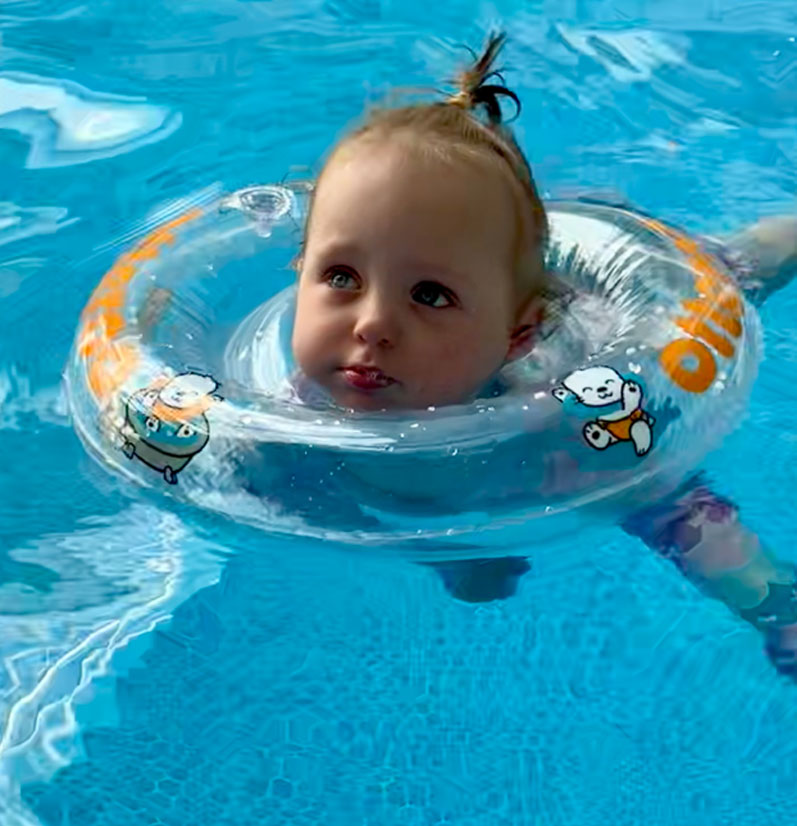
Meet Margot
Margot was born healthy with no complications in 2021. At 3 months old, she started having focal seizures and needed genetic testing. The testing revealed a diagnosis of a new de novo mutation in the SCN8A gene. Margot is the only known patient with her specific mutation, making her nano-rare.
Since diagnosis, Margot has developed infantile spasms, a catastrophic type of epilepsy. She has been on 11 anti-epileptic drugs, but still has up to 80 tonic and clonic seizures a day. The SCN8A gene regulates many functions that involve the brain. As a result of her mutation, Margot’s muscles don’t work well either: she has low muscle tone and cannot control her head or sit up. She also has cortical visual impairment, meaning her brain cannot process visual input, and has trouble seeing. Margot powers through 7 hours of therapy each week to work on various skills and strengthen her body.
n-Lorem brings Margot’s family hope for their precious baby girl and for all other patients affected by nano-rare diseases.
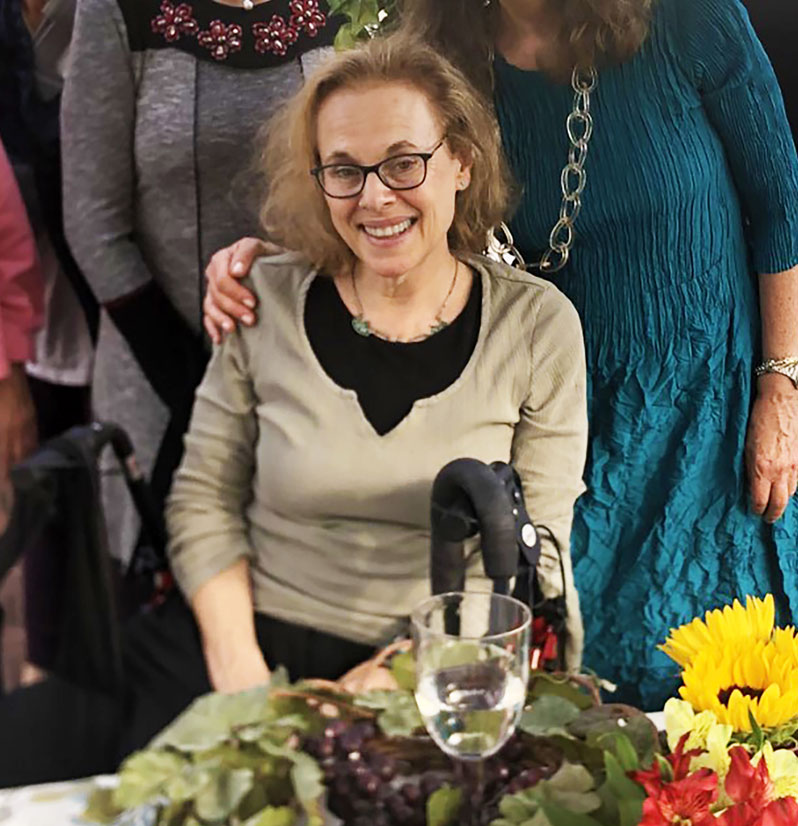
Meet Heidi
Heidi’s symptoms began 12 years ago with urinary problems. That, and the extreme fatigue she was experiencing, caused her to retire from public school teaching near the end of 2016. Her symptoms progressed to tingling and pain in the legs and feet. She consulted numerous doctors for her symptoms unsuccessfully for years before, in 2018, a neurologist finally ordered an MRI of the brain and spine. The results of the MRI (leukodystrophy, atrophy) were bewildering: abnormal, but not typical of what is seen in multiple sclerosis. Puzzled, the neurologist referred her to the Undiagnosed Diseases Program (UDP) at the National Institutes of Health.
After many tests, the UDP diagnosed her with Adult Polyglucosan Body Disease (APBD), a genetic disorder which typically manifests in one’s 50s. They told her that not only did she have this very rare disease, but that she also suffers from a nano-rare variant of the disease. There are currently no treatment options for APBD.
Heidi exists in constant, severe daily pain. She relies on a walker or wheelchair to get around the house and cannot drive anymore. Her leg strength and function continue to decline, while her pain continues to increase. She also suffers from extreme daily fatigue. She has tried numerous experimental pain treatments to no avail. Heidi has also experimented with a restrictive diet for the past two years in an effort to slow the disease progression. It is unclear whether or not the diet is effective. She voluntarily shares all of her medical data with a researcher looking for additional clues to her disease’s pathology.
Prior to the onset of APBD, Heidi was a very active and dynamic person. She was a college athlete (swimming) and continued to swim, do yoga, and exercise as an adult — until the illness made that impossible. These days, she doesn’t go out much and doesn’t see friends as she used to. An extraordinarily self-sufficient and giving person, the disease has taken away her independence and challenged her confidence. At this point, even having the energy to eat is a challenge. Once a prolific painter, she is no longer active in her studio and does not paint or draw. Playing with her grandchildren or taking them places is difficult or impossible. While she can still use her hands, she is terrified of losing that ability and more.
Heidi lives in hopes of an effective ASO treatment for APBD, one that will improve the quality of her life and the lives of others living with the disease as well. Slowing or reversing the course of the disease would change her life. Because the disease is genetic, she worries that her children or grandchildren will suffer from it as well. At this time, one of her adult children may be exhibiting early symptoms of APBD. She hopes that any effective ASO for treatment for APBD will help the many others who suffer from glycogen storage diseases.
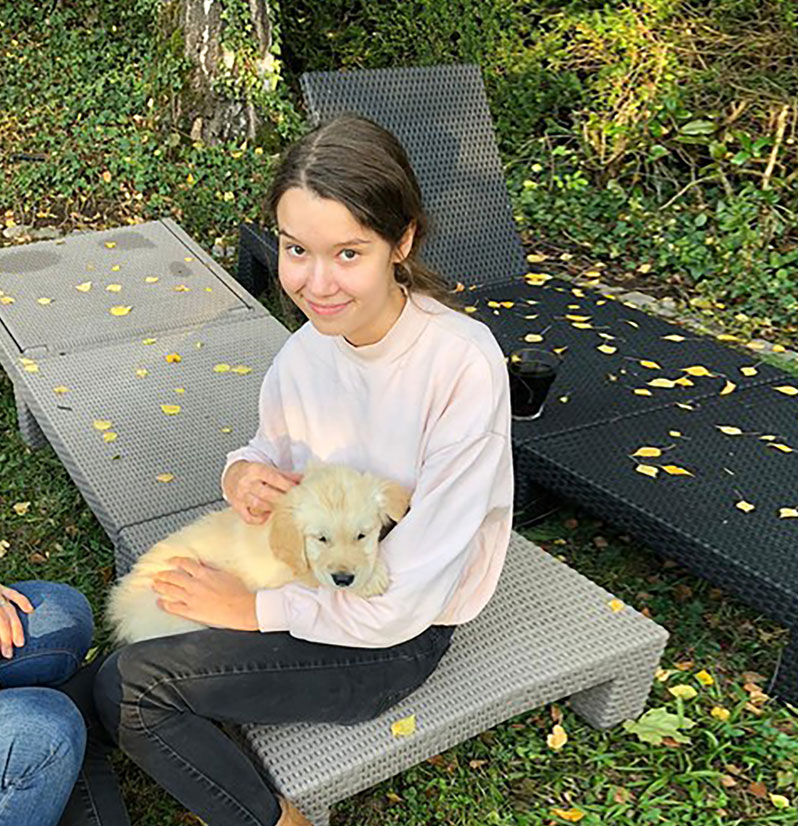
Meet Anna
In November 2019, Anna, now 15 years old, began to speak in a strange way: After every second or third word, she took a deep breath. Her mother thought she might have developed a tic and, to be honest, she wasn’t too worried. However, since Anna constantly had severe headaches – combined with nausea and vomiting – after sports and at the end of a long school day, her mother was concerned.
The doctors consulted were faced with a puzzle: various diagnoses followed over the next few months: hormonal disorders, psychosomatic problems, allergy, myasthenia … none of them applied. Meanwhile, Anna became increasingly weak, she fell asleep at the table during the day, she could no longer hold her head up, and short distances on foot already tired her enormously.
On October 20th, 2020, the family’s world collapsed: a genetic diagnosis had been made and they received the diagnosis: amyotrophic lateral sclerosis (ALS) caused by a rare mutation in a gene that causes a severe, aggressive form of ALS. The family was devastated. Week after week, Anna lost other functions: speaking, swallowing, moving, facial expressions, gestures – everything decreased. In early November 2020, Anna underwent a percutaneous endoscopic gastrostomy (PEG), which increasingly became the only way she could feed herself. The family was desperate, but they didn’t want to give up.
Through Anna’s grandfather, a former family physician, and his friend, a professor of genetics in Newark, the family came into contact with Dr. Neil Shneider, a leading ALS researcher and physician. Dr. Shneider was instrumental in the administration of an experimental ASO that was discovered and developed for Jaci Hermstad. Jaci Hermstad was a true heroine, and despite living longer than expected, she sadly progressed from her disease in the spring of 2020. As it turned out Jaci and Anna shared the same aggressive form of ALS. As treatment was not possible in Germany, Anna and her mother flew from Germany directly to New York on December 12th, 2020, where Anna received the first dose of JaciFUSen, named after Jaci, on December 15th, 2020 at the Columbia University Irving Medical Center/The Neurological Institute of New York/New York Presbyterian Hospital. The openness, warmth and empathy that Dr. Schneider and his team welcomed them with was overwhelming. With Anna, the team felt that they had an opportunity to treat at an earlier stage in disease and that they would get the chance to do everything possible for Anna.
Anna wants to prove that not only can you survive with ALS, but you can also live a good life. She does this for herself, for her family and friends, for her beloved dog Snoopy, for Neil, for Dr. Stanley Crooke and all the doctors and therapists who believed in her,’ and especially for Jaci Hermstad, her personal heroine, whom she would have loved to meet and speak to.
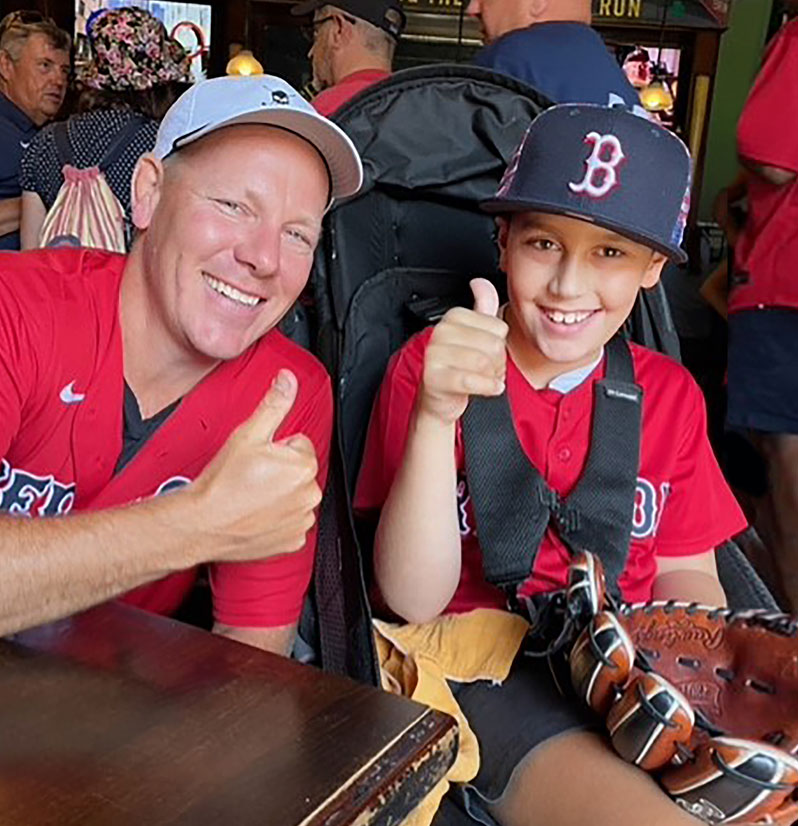
Meet Mostyn
The purest example of Mostyn’s character emerged in the spring of 2021. Mostyn’s parents were taking him to quite a few baseball games. He was so excited to be back in ballparks after the loosening of Covid-19 restrictions and had become pretty much obsessed with getting a game ball. Mostyn and his parents were at a game sitting about fifteen rows above the New York Yankee’s dugout. There was another little boy and his father at the end of the row. The boy was a young teen and Mostyn was nine. The boy was very sharp, and he knew most of the players’ names in Spanish and English. He collected four baseballs by running up and down the aisle and calling for a ball each time the players came off the field. Near the end of the game, the Yankees were returning to their dugout when their first baseman, Luke Voit, threw a ball towards Mostyn. His father caught the ball and handed it to Mostyn, as the crowd let out a nice applause. Mostyn hobbled down the row toward the boy and his father. They looked at Mostyn, but he did not say anything. Mostyn took the ball out of his glove and put it in the boy’s glove. The father told the boy, “No, you cannot keep that ball” so the boy handed it back to Mostyn. But, Mostyn put the ball back in the boy’s glove before turning and walking away. The crowd erupted with emotion and many people came up to meet Mostyn at the games thereafter.
On a good day, many people would not realize Mostyn has suffered thousands of seizures. He has been on extremely high doses of at least three anticonvulsants, exclusive of rescue medications, has had multiple reconstructive surgeries on his legs and feet, has learned to walk four times, and he has a feeding tube. On a tough day, Mostyn fights as hard as he can to stay alive. He convulses over and over, his oxygen level drops, he turns blue, chokes, vomits, wakes up with ringing in his ears, loses his coordination and his ability to walk, and he gets very scared. The rescue medications compound the side effects of his daily medications, despite additional medications to counterbalance them, which have even more side effects. The medications can suppress his blood pressure, heart rate, and his ability to breathe on his own. Even slight adjustments can have major impacts on Mostyn’s emotions.
Mostyn is an only child. His parents have been extremely dedicated to his wellbeing, even prior to his birth. During pregnancy, his mother was diligent with her diet, took prenatal vitamins, avoided alcohol and fish, and drank plenty of water. Mostyn was delivered naturally with no drugs, precisely on his due date. At birth, his parents opted for optional genetic testing that was offered to them. Everything seemed to be in order and Mostyn and his mother were discharged after spending just one night in the hospital.
Mostyn was a wonderful baby. He had a good appetite and an amazing personality. He was a little slow to start walking, but his pediatrician assured his parents that everything was fine and boys sometimes take longer than girls to start walking.
When Mostyn was three, it was clear he had some developmental delays. His parents took him to a neurologist who ordered an electroencephalogram (EEG) and a brain MRI. The EEG presented some abnormal activity, but neither the MRI nor the doctor yielded any further explanations. Mostyn presented signs of cerebral palsy, hypotonia, and dyspraxia.
By the age of four, he was already in over ten hours of therapy each week: occupational, speech, and physical. Despite this, his gait was abnormal, and his wrists were weak and floppy. Kids started calling him names and making fun of him, while adults said far more hurtful things. His parents tried many things to help him like massage therapy, electrical nerve stimulation, and kinetic tape but nothing seemed to work very well. Then, one day, his father came home with a baseball glove for him, and they started playing catch every day. Beyond strengthening his wrists, Mostyn fell in love with the game of baseball, and has been wearing a baseball glove every single day for over seven years now.
Even at the age of five, speech was difficult, but he worked very hard with speech therapists to expand his vocabulary to nearly one hundred words. He was able to walk, run, climb stairs, speak, swallow, eat and drink. Then, on New Year’s Eve in 2016, Mostyn suffered an extremely violent tonic clonic seizure that lasted several minutes. Within a few weeks, he was having over thirty tonic clonic seizures a day. Mostyn’s parents took him to an emergency room, and he was later transferred to the epilepsy floor. After a couple days, a doctor came to Mostyn’s room and informed his parents that he had Lennox Gastaut Syndrome. His father asked what that meant and what his life expectancy would be. In tears, the doctor left the room. By the time Mostyn was discharged from the hospital several days later, Mostyn could no longer stand on his own. He was having tonic clonic, absence, atonic and myoclonic seizures. His parents took him home, covered all of their windows, barricaded their front door, turned off all of the lights, televisions, radios and tried to avoid any sort of stimulation, but the seizures continued. Mostyn had multiple additional EEGs, another brain MRI and multiple genetic panels performed that provided no clear answers.
His parents continued to seek the underlying cause of Mostyn’s severe refractory epilepsy, rather than settle for treatment of his symptoms. They took Mostyn to Boston Children’s Hospital, where his new neurologists were able to identify the cause of Mostyn’s epilepsy and other neurologic symptoms – a unique de novo heterozygous mutation of a gene called KCNB1. Mostyn is currently the only known case in the world with his variant, making him nano-rare. There are currently no treatment options for Mostyn’s condition, and he continues to decline. However, Mostyn and his family hope and pray that, one day, an ASO can be discovered and developed just for him.
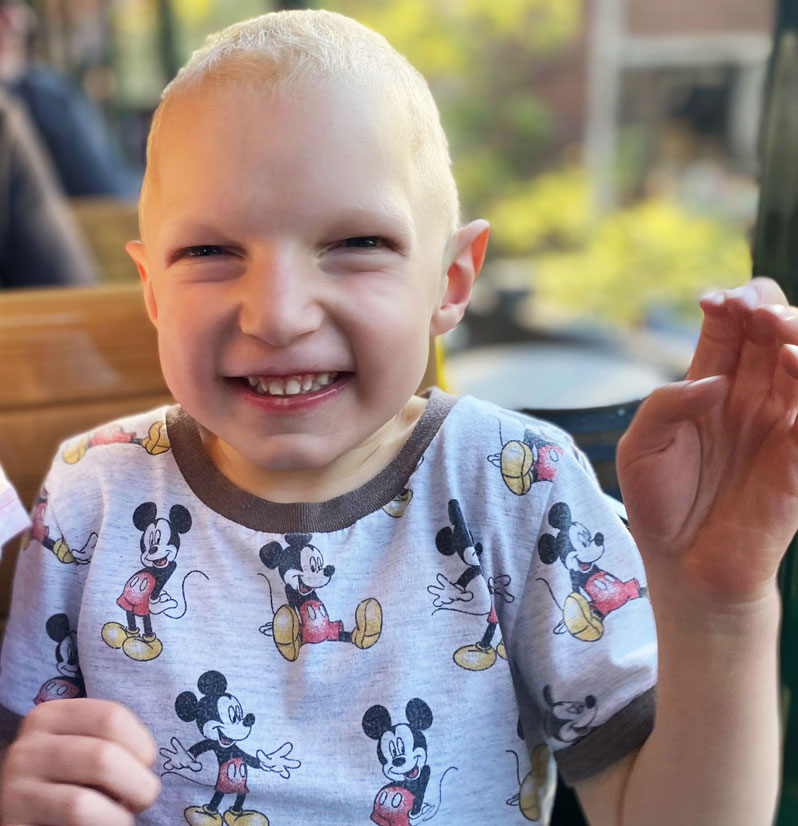
Meet Ethan
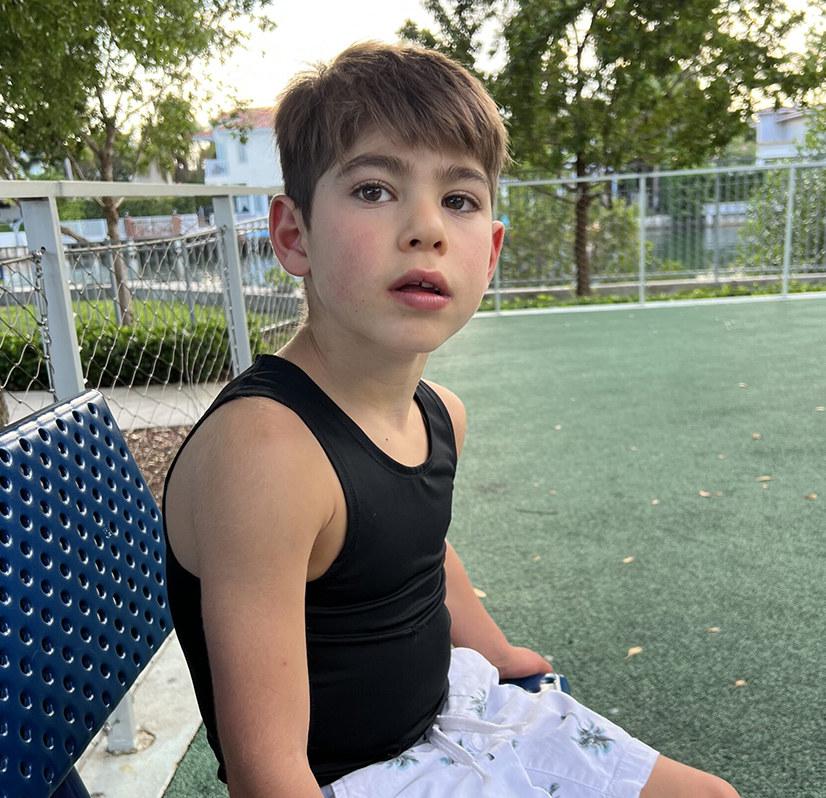
Meet Roger
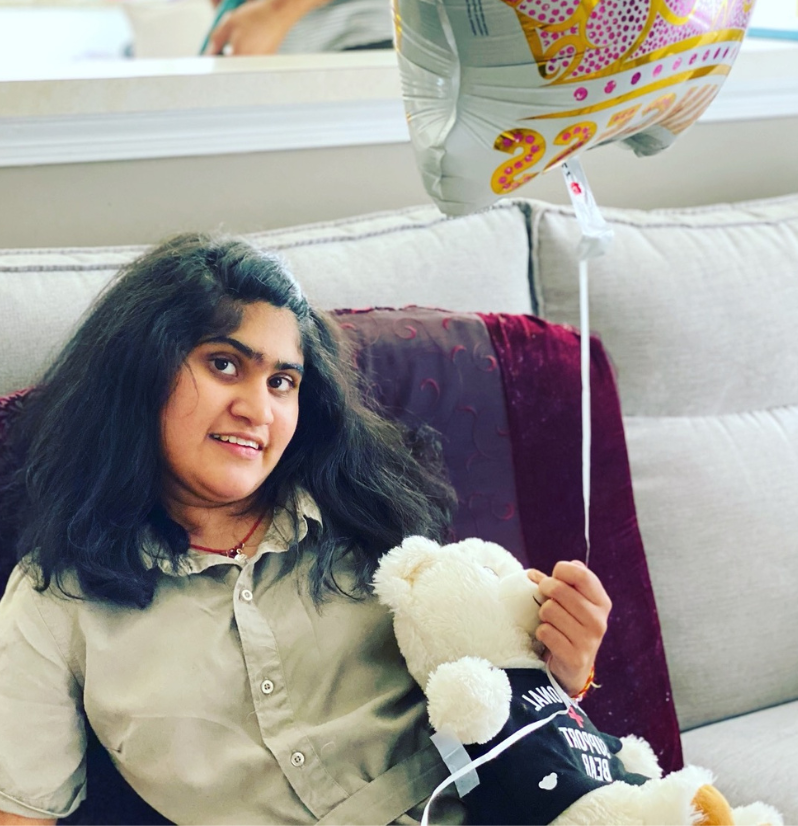
Meet Jiya
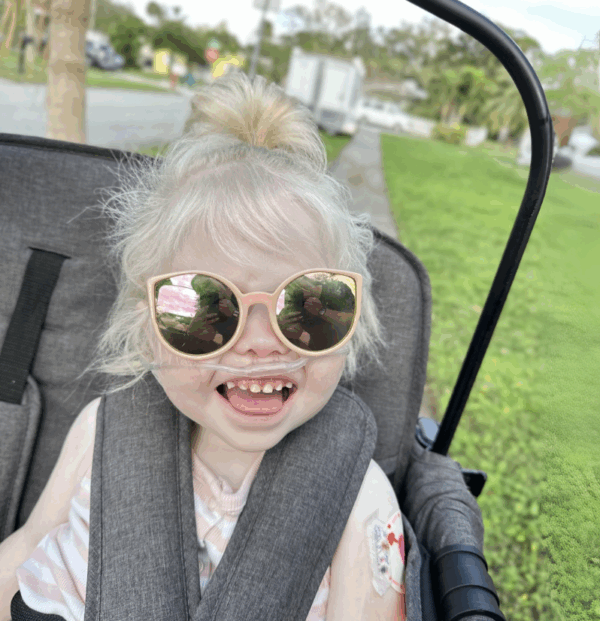
Meet Emersyn
When Emersyn was born in February 2021, she shocked everyone with her bright white head of hair and a tiny dimple/indentation on her forehead. After 20 hours with feeding difficulties, Emersyn was transferred to a children’s hospital, and then to an even bigger hospital (one we would eventually become very familiar with) and neonatal intensive care unit where she was able to get her foot in the door with her eventual geneticists. Emersyn has spent the majority of her first 2 years being poked, imaged, and tested. After two normal genetic panels, she had a whole exome sequencing test performed that revealed a CLCN7 diagnosis. Soon after, it was revealed that Emersyn is only 1 of 3 known cases in the world and, at this point, the only living case.
From November 2021 – August 2022, Emersyn spent all but 80 days (about 2 and a half months) in the hospital and multiple weeks in the ICU. Her family is thankful to have her home as much as possible. Although, they know she is extremely loved in the hospital – her second home.
Despite everything Emersyn has been through, she is extremely happy! Emersyn loves playing with her 3 older siblings on the floor and sometimes forgets that she is not an only child. Emersyn loves all things Ms. Rachel, Taylor Swift music, or anything that you can dance to.
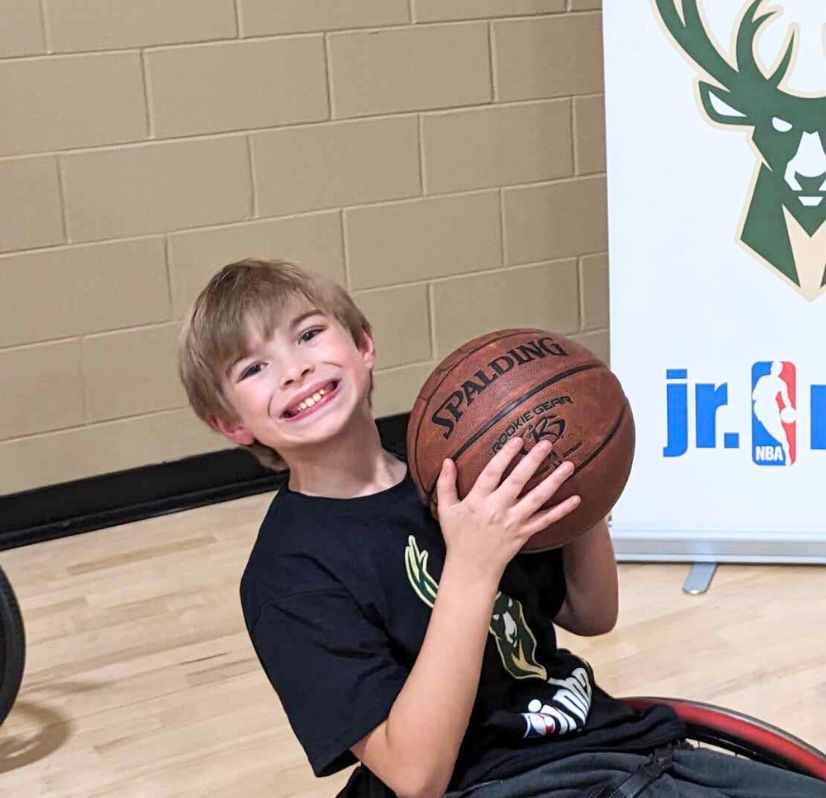
“Our family was devastated when our son was diagnosed with a progressive neurodegenerative nano-rare disease with no cure, KIF1A.
Having a child diagnosed as nano-rare brought us great worry that research would be limited, treatment was out of reach, and Gunnar would be left behind.
n-Lorem’s commitment to develop and provide treatments to nano-rare patients has brought us hope for his future. We are forever grateful to n-Lorem for giving our son the gift of potentially having a brighter tomorrow. ”
Meet Gunnar
Gunnar started physical and occupational therapy, underwent serial casting, and started wearing leg braces. Despite these interventions, there was no improvement in his condition and his mobility continued to decline.
Genetic testing revealed a nano-rare mutation of Gunnar’s KIF1A gene. Initially diagnosed with Spastic Diplegic Cerebral Palsy, Gunnar’s diagnosis changed to KIF1A Associated Neurological Disorder and Hereditary Spastic Paraplegia.
Gunnar had surgery to reduce spasticity and orthopedic surgery to improve mobility, and he continues to work very hard to maintain his current level of ambulation. He is an ambulatory wheelchair user and enjoys playing adaptive sports – his favorite being wheelchair basketball.
Gunnar likes to make art projects and build Legos with his younger sister, Raegan. He also enjoys helping in the kitchen and baking with his mom and playing board games with his dad.
Gunnar’s favorite movie is Ghostbusters. Seeing the firehouse and other locations from the movie was a dream come true for Gunnar during a trip to NYC for a KIF1A study.
Gunnar is kind, funny, and loves to crack jokes. But he’s also brave and tough. Even on his worst days, if you ask him how he is doing, he will give you a thumbs up. Gunnar truly is rare and one of a kind.
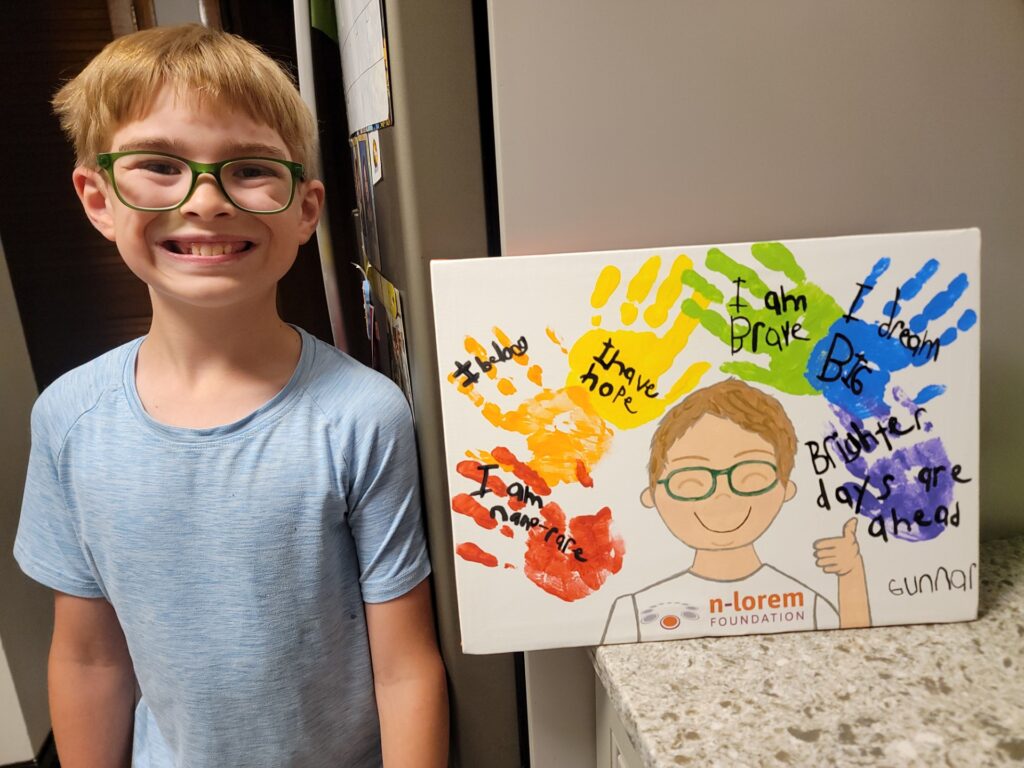
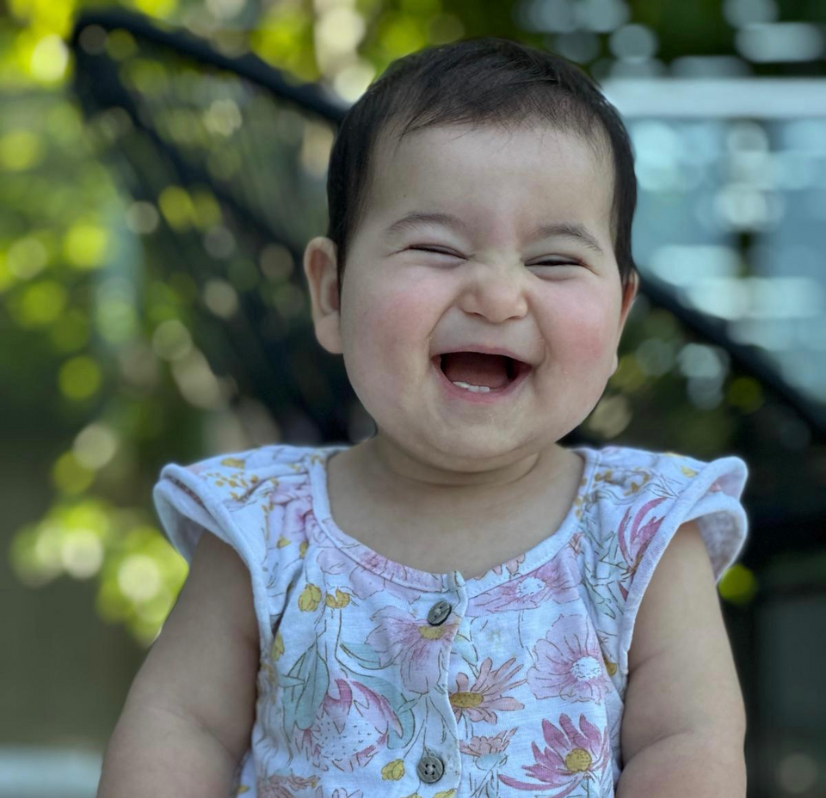
Meet Talia
Talia had her first seizure at 4 months old. After a series of hospital admissions, Talia was diagnosed with Epilepsy which qualified her for rapid genetic testing. When Talia was 6 months old, she was diagnosed with a very rare genetic condition called NARS-1. There are less than 15 known cases worldwide with Talia’s specific condition which causes epilepsy, global developmental delay, intellectual disability and microcephaly.
Since her diagnosis, Talia has been getting regular physio, OT, and speech support. She is very determined to learn and is working hard to grow and develop. Her persistence and focus give her parents a lot of pride as she continues to push all the boundaries.
When Talia’s parents received the diagnosis, they were told effectively that there was nothing more the doctors could do, and that they had to live with the reality of the circumstance. While her parents feel incredibly lucky to have this little girl in their lives, under any circumstances, they are beyond grateful for n-Lorem which has given them hope via a pathway for Talia that may allow her to overcome her challenges with NARS-1.
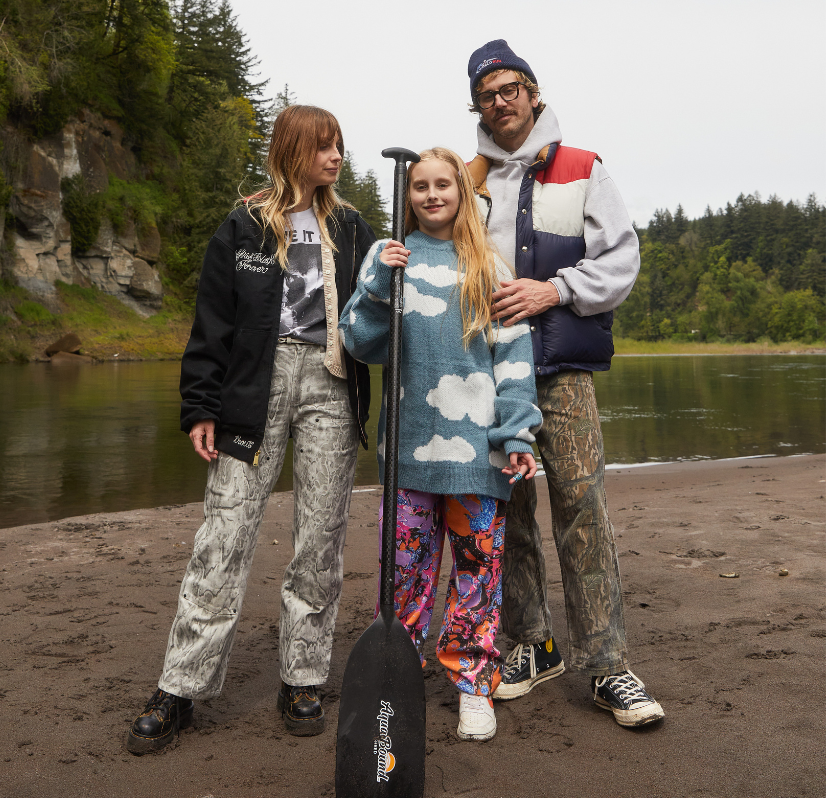
“We are so grateful for the opportunity of possible treatment through n-Lorem. Knowing that someone is trying to do something for those completely unserved is a relief. We were sent home with no advice but to go home and experience a progressive neurodegenerative disease. This was absolutely crushing. To have hope for her future and possibly provide her a chance to keep singing and dancing and enjoying jokes. Nothing in this world means as much to us.”
Meet Frances
Her parents started to notice that milestones were not being met and that she had some learning and speech delays, and behavioral challenges around 3 years old. Preschool was difficult for her to attend, then came the discovery she had hypotonia and tremor in her hands. In addition to this, she would also get fevers, vomit regularly and would get debilitating migraines and sleep the whole day. This was often short lived, and she would bounce back quickly, making it hard for anyone to have too much cause for concern.
Unfortunately, with these symptoms seeming mild, she was not diagnosed with a rare disease for almost 7 years. In 2021, at 9.5 years old, Frances started experiencing sudden episodes of collapsing to the ground, accompanied by fluttering eyes and slumping over. Her arms would sometimes jerk. This got progressively worse, and an EEG was done confirming myoclonic, atonic, and absence seizures. Genetic testing was advised, and she was diagnosed with a rare mutation in the DHDDS gene shortly after.
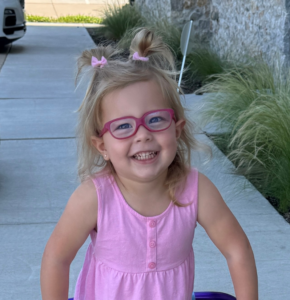
“Thanks to Kinsley’s acceptance into n-Lorem, we’ve found a sense of hope that grows stronger each day, grounded in the knowledge that the most dedicated ASO experts are crafting a personalized treatment just for her. Inspired by this hope, I, along with Daphne Graskewicz-Prado, created the Kinslow TUBB4A Foundation (www.tubb4a.org) to advocate for other families navigating TUBB4A leukodystrophy.”
Meet Kinsley
Early in her life, Kinsley’s parents noticed that she wasn’t progressing as quickly as her peers. Their first concerns were raised when, by her first birthday, she was only army crawling. In an effort to help her progress, she was placed in physical therapy which, while initially helpful, began to uncover further challenges. By 15 months, her parents noticed that she had begun to drag her toe with each step. Then by 18 months, a new symptom appeared: nystagmus, a rapid, uncontrollable movement of the eyes.
A close family friend, who also happens to be an ophthalmologist, made a few suggestions but ultimately recommended a thorough checkup. This recommendation led through a path of doctors and ultimately to an MRI to rule out a brain tumor. The results of that MRI were both a relief, in that no tumor was present, and concerning as they revealed Kinsley had less white matter than other children her age. This discovery was the springboard for a series of tests and consultations to find the right doctors, who had any answers to what was happening. In May 2023, just a few months past Kinsley’s second birthday, a diagnosis finally came: an extremely rare mutation in the TUBB4A gene. With this diagnosis came a wave of both relief and motivation for her family as it provided both answers and new challenges to navigate.
Despite these hurdles, Kinsley’s determination never wavers. She relies on a walker and orthotics making everyday movement difficult. To compound those hurdles, she is constantly fighting imbalance and difficulty with fine motor tasks. Her greatest dream is to run and play freely with her peers, but her rigid movements and equipment often make this a challenge. Kinsley’s weekly schedule is packed with therapies to help her develop skills most take for granted – from physical therapy and hippotherapy to occupational and speech therapy. Her hard work and determination are yielding results. She is working to build core strength, has learned to stand from a sitting position, and she has even learned to stand independently – albeit for brief moments. Recently, she has proudly taken her first steps and learned to undress herself, small victories that have meant the world to her and her family.
Kinsley’s family has embraced a “practice makes permanent” mentality, encouraging her to push her limits daily. Their steadfast support, combined with Kinsley’s incredible resilience, has made for a powerful force. It is this spirit of resilience and unending joy that Kinsley uses to inspire everyone who meets her, filling them with hope and happiness.
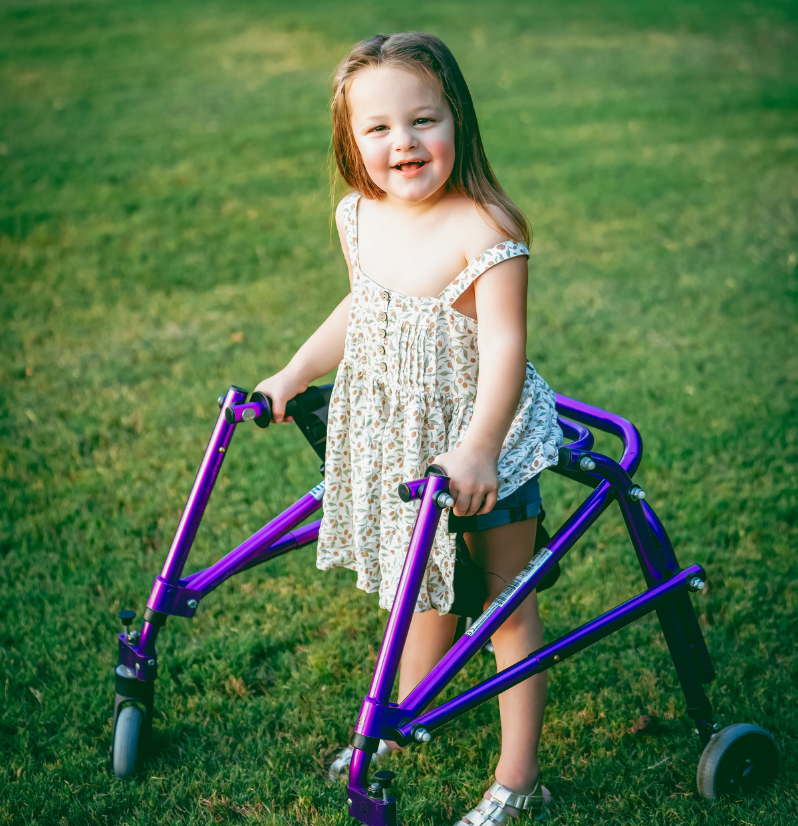
Meet Emmery
When Emmery was 9 months old, her parents started taking her to Physical Therapy because she wasn’t sitting up on her own yet, and her neck wasn’t quite as strong as expected. She hit most of her milestones on the later end of normal, while her twin brother was hitting them early. She quickly graduated from PT.
At 10 months, her parents noticed one of her eyes occasionally crossed, and she was prescribed glasses. She began crawling and pulling up, and her parents were so glad as they thought this was the solution to her delays.
At 16 months, Emmery saw a Developmental Specialist who suggested she was just a little behind for her age and nothing was of concern.
At 19 months old, Emmery visited a Geneticist who initially believed nothing to be wrong but decided to conduct tests for confirmation. Initial tests returned normal results, prompting a recommendation for Whole Genome Sequencing. However, the family’s insurance initially refused coverage, leading to an eight-month struggle with the insurance company.
By 22 months, a Neurologist suspected a genetic disorder and supported the need for Whole Genome Sequencing. With the Neurologist’s assistance, Emmery’s family continued and ultimately won their fight with the insurance company. Finally, on February 8, 2022, Emmery received a diagnosis of KIF1A Associated Neurological Disorder.
Everyone agrees that Emmery is so strong, brave, and tough as she goes to multiple therapies every week and multiple doctor appointments every month. She works so hard and is extremely motivated. There’s nothing better than seeing the huge smile on her face after she’s accomplished a new task. Emmery is truly an inspiration to everyone.
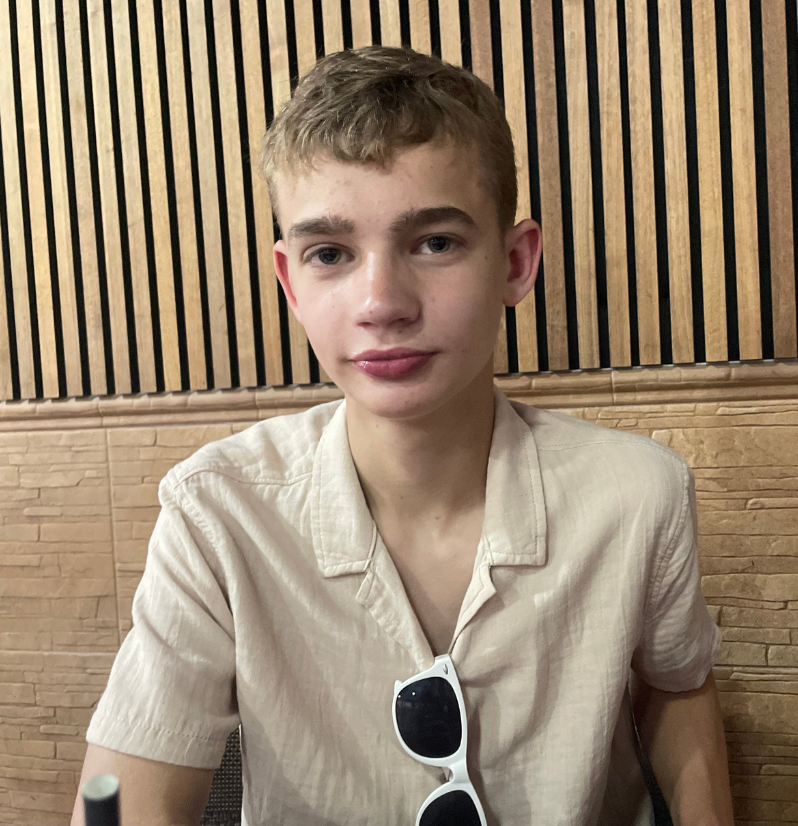
“When we were told that two of our three children carried an ultra-rare, neurodegenerative DHDDS gene mutation, our world fell apart. The thought of having to watch not one but two of our children deteriorate physically and possibly mentally, without being able to help, was truly devastating. n-Lorem has given us hope in our darkest times—hope that a treatment pathway can be developed so that our children can enjoy the fullest life possible, and hope that they can intervene to stop this mutation from stealing away their futures.”
Meet Tom
Tom’s parents noticed that he was late with key milestones such as pointing, babbling, and clapping. When he began walking, he was clumsier than other kids and would fall more easily. Tom’s speech was also late to develop, and as a child, he would often be more interested in playing with toys than with other children.
At age four, they noticed a mild hand tremor, and when he started school, the gap between Tom and kids his age became increasingly noticeable. Tom underwent a panel of genetic testing at age ten, which came back normal. By this time, he also had diagnoses of dyspraxia and autism.
At age twelve, following growing concerns about his increasing tremor and muscle twitches, Tom had whole-genome sequencing. Fourteen months later, Tom’s family received the news that both Tom and his younger sister carried a pathogenic DHDDS mutation.
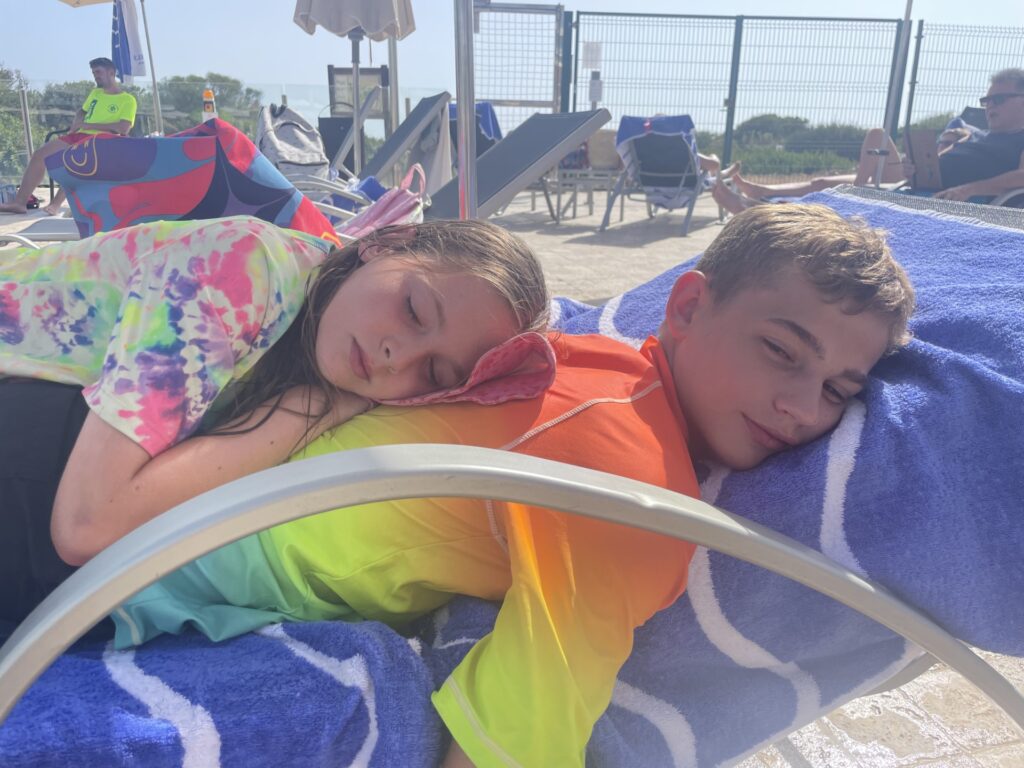
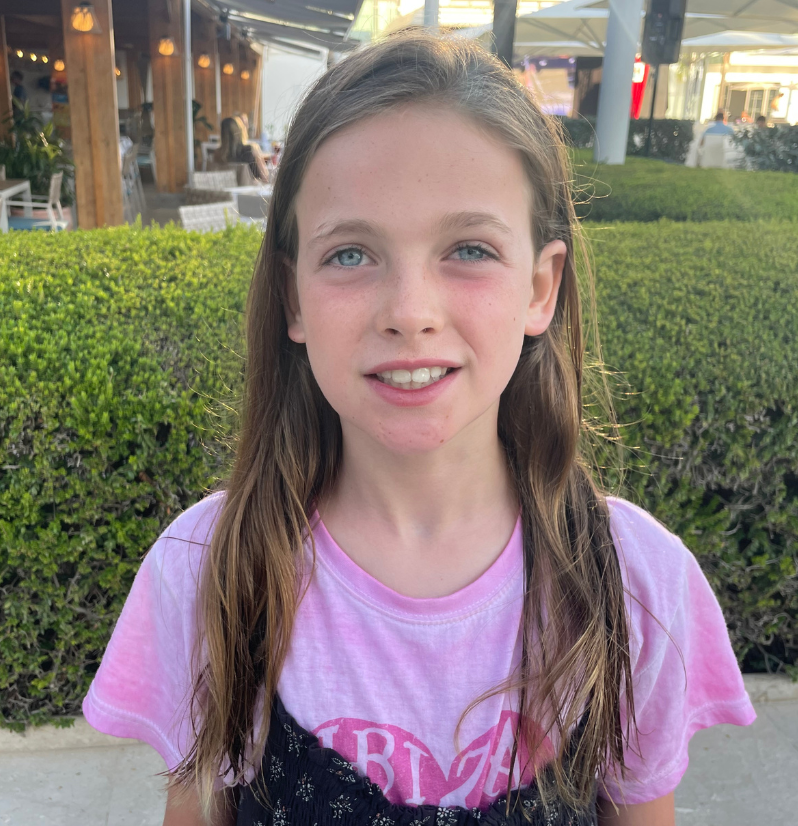
“When we were told that two of our three children carried an ultra-rare, neurodegenerative DHDDS gene mutation, our world fell apart. The thought of having to watch not one but two of our children deteriorate physically and possibly mentally, without being able to help, was truly devastating. n-Lorem has given us hope in our darkest times—hope that a treatment pathway can be developed so that our children can enjoy the fullest life possible, and hope that they can intervene to stop this mutation from stealing away their futures.”
Meet Rosie
Rosie’s parents noticed that she trembled, much like her big brother Tom, from birth. They anxiously watched her development and saw many similar delays to those her brother had encountered. Like Tom, she struggled with her motor skills and would easily trip over. While Rosie’s spoken language developed well, she struggled with her receptive language and found learning difficult. However, like Tom, it was the tremor that concerned them the most, as her little arms and hands would tremble whenever she tried to do anything.
When Rosie’s big brother Tom had his whole genome sequenced, it was suggested that Rosie be tested too. Fourteen months later, the family received the news that both of their children carried a pathogenic DHDDS gene mutation.
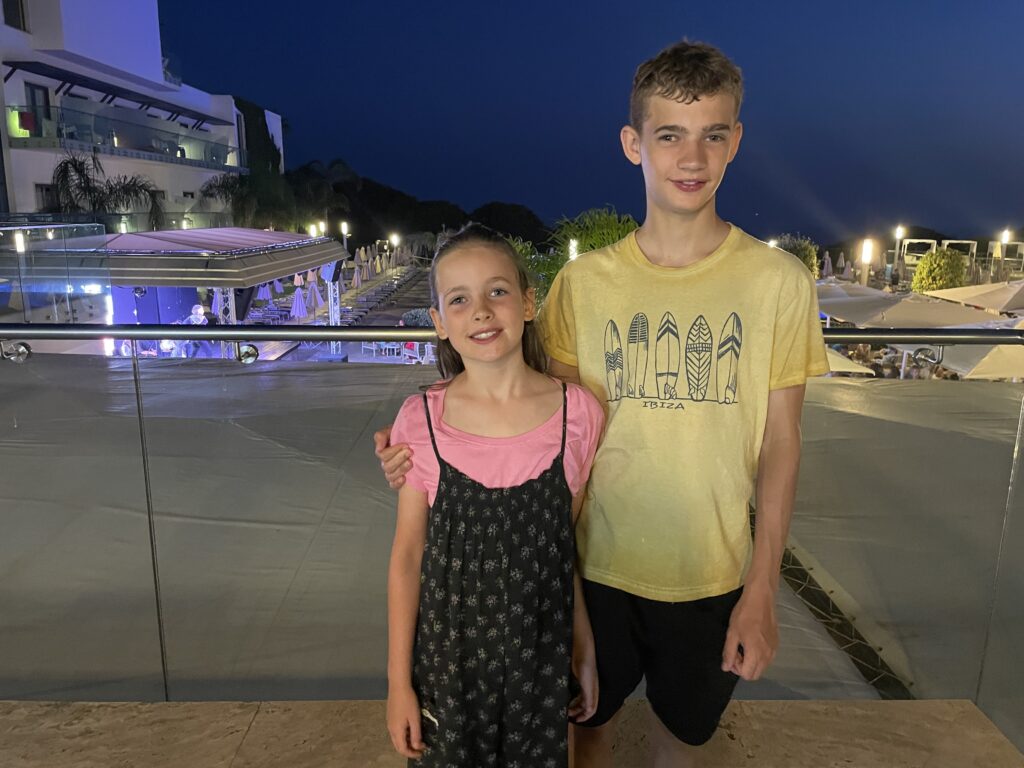
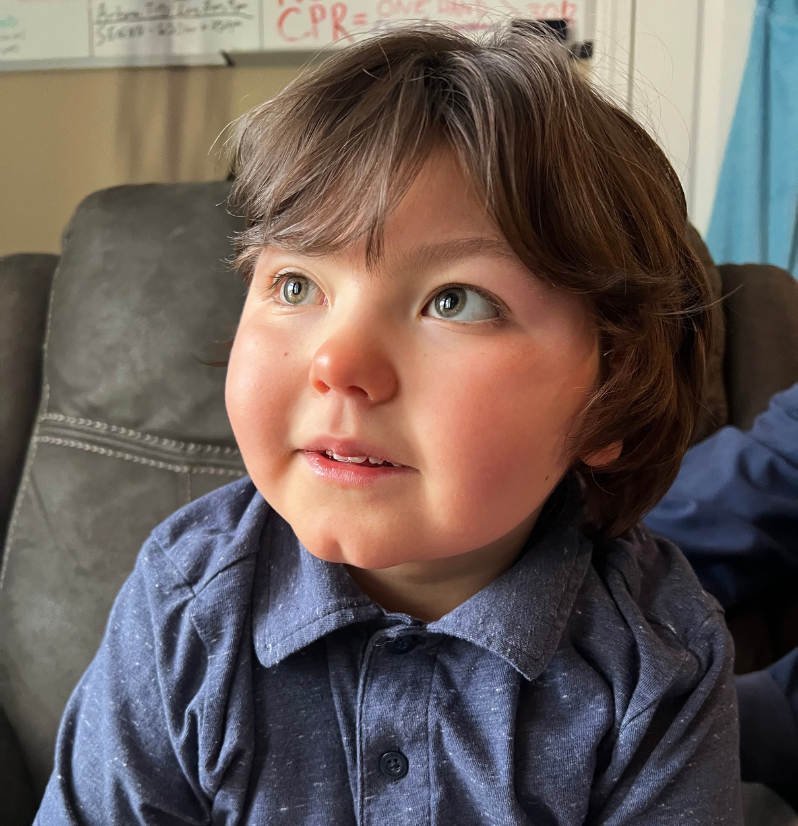
Meet Nolan
Nolan is severely disabled and globally delayed, and 100% dependent on caregivers. He is nonverbal and blind (CVI), and he also cannot independently sit up, crawl, stand, or walk. Nolan is fed through a gastrostomy tube, has active seizures and dystonia, requires frequent suctioning, and wears a CPAP nightly. Nolan is on a plethora of medications and needs frequent therapies. He is completely non-ambulatory, requiring special medical durable seating equipment and a wheelchair. His parents have been told during his numerous hospitalizations to prepare for the possibility of Nolan not going home. Fortunately, Nolan has repeatedly defied the odds and persevered, showing grit, incredible strength and a will to live.
Nolan is a happy little boy who loves his family and adventure. He enjoys his trips to the beach, mountain, or parks. Nolan prefers to be outside when the weather is just right and loves the feel of a cool breeze on his face. He has diverse musical tastes. He is cheeky, with a great sense of humor. He attends a special needs school where he has lots of friends. He loves to cuddle. But most of all, Nolan loves his big brother.
If you want to see the purest definition of love, all you need do is watch Thomas with Nolan. Thomas is Nolan’s best friend and biggest cheerleader. If you were to ask him what he would like most in the world, his reply would invariably be to make his brother better.
Nolan continues to surprise his medical team and family with his fortitude. If given the right modern treatment, no one can say what Nolan may be able to achieve. One thing is certain, however – Thomas will hold his hand every step of the way.
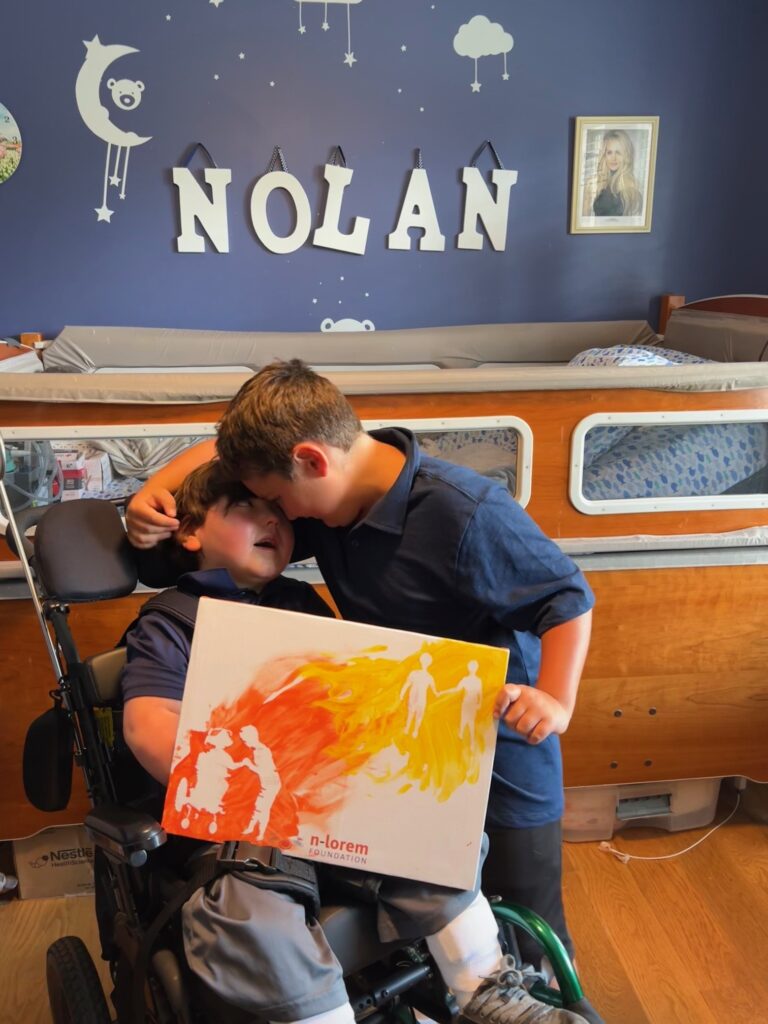
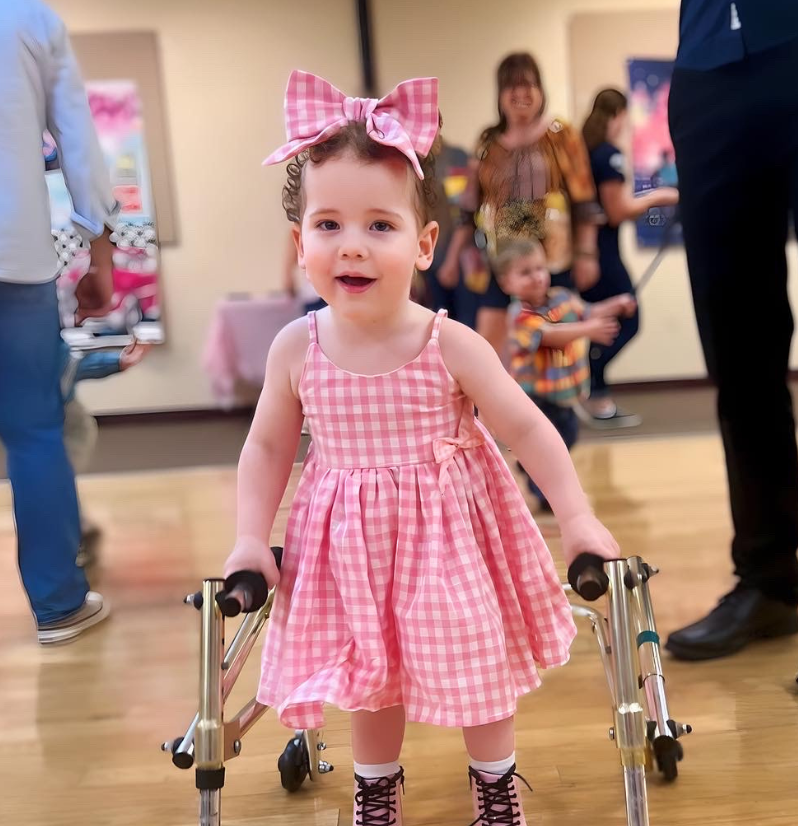
Meet Harlow
Known for her fierce personality, quick wit, and intelligence, Harlow embraces life with a passion that is truly inspiring. She adores her siblings — her little sister Hope and big brother Henry — and has a special love for all things pink. A true nature lover, she thrives outdoors, cherishing beach days and having a soft spot for animals. With her trusty posterior walker, she dances through life, refusing to let anything dim her sparkle.
Harlow’s journey to diagnosis began when she hadn’t started walking independently by 18 months, prompting her family’s quest for answers. An MRI revealed less than normal white matter for her age, leading to genetic testing that confirmed the TUBB4A diagnosis. Although her doctor could provide little information about this rare condition, he offered a glimmer of hope: the n-Lorem Foundation had recently visited and presented at Vanderbilt University, and he believed Harlow might qualify as a potential n-Lorem patient. A little over six months post diagnosis, her program was accepted by n-Lorem.
To know Harlow is to feel her warmth envelop you. Her heartfelt hugs serve as a reminder of the pure goodness in the world, even amid adversity. While TUBB4A leukodystrophy presents daunting challenges, Harlow’s family is committed to cherishing every moment with her, raising awareness, and finding hope in their journey together. Harlow’s spirit is unbreakable, and her story is one of love, resilience, and joy.
Every night, Harlow shares a special mantra with her mother: “Let’s Change the World Together.” With the support of n-Lorem and her unwavering spirit, Harlow plans to make a lasting impact as a beacon of hope, proving that even in the face of challenges, love and determination can light the way.
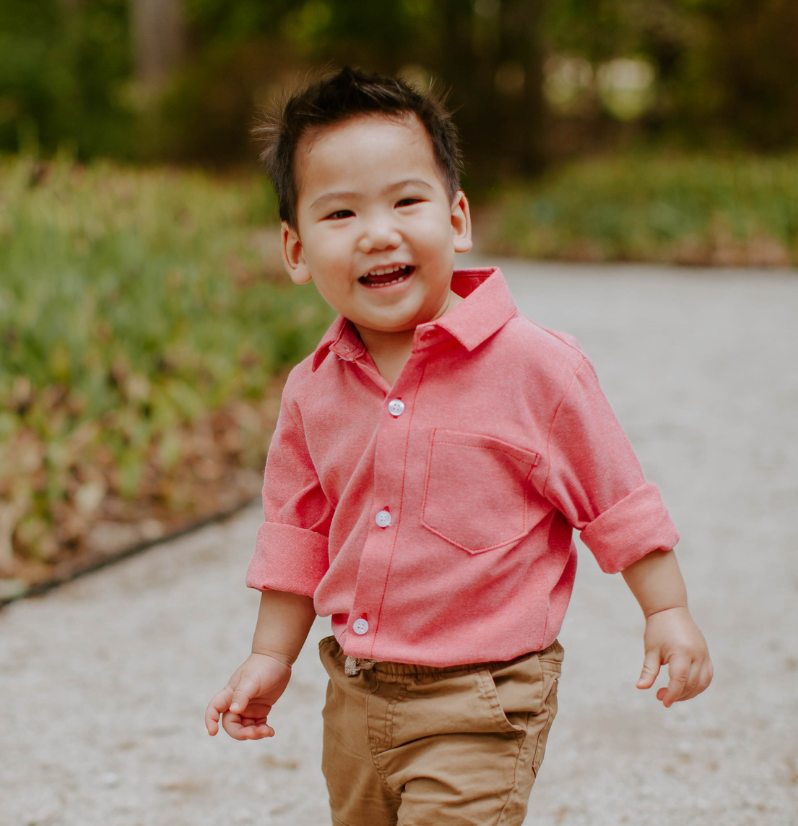
Meet Connor L.
Determined to find answers, they pursued an MRI, EEG, and extensive bloodwork. As they waited for results, they began noticing more of Connor’s tonic seizures and a series of involuntary movements that appeared seizure-like, though later doctors would rule them out as such. During this time, Connor’s developmental milestones began to slow. He stopped reaching for new skills, from rolling over to pulling up, crawling, and walking. His early babbling, once frequent and joyful, began to fade until he barely made a sound.
After many tests and consultations, Connor was finally diagnosed with a rare genetic mutation, RHOBTB2 (c.1532G>A(p.Arg511Gln)), a condition that affects only a small number of people worldwide. This mutation is known to cause neurological symptoms, including developmental delays, epilepsy, and movement disorders. Children with this mutation often experience tonic seizures, muscle stiffness, and other involuntary movements. Developmental milestones are typically significantly delayed, with many children struggling with motor skills, speech, and communication. Connor’s own symptoms—his seizures, movement difficulties, and delayed milestones—fit this profile, providing clarity on his unique needs and how best to support him.
Despite these hurdles, Connor’s spirit shines brightly. He has a few quirks that bring joy to those around him: a love for bright, colorful toys and a fascination with sensory activities, like playing with his piggy bank and opening different toys and objects. Simple joys bring him happiness, and his family finds that moments spent listening to his favorite Baby Shark music or engaging in playful interaction are some of his most cherished times. His laughter is infectious, and he has an uncanny ability to surprise his family with moments of insight and connection, reminding them of his resilience and strength.
Connor’s family continues to support him in every way possible, providing him with love, patience, and the specialized care he needs. They hold onto hope that ongoing research will lead to advancements that could improve his quality of life. His journey, though challenging, is marked by the unwavering support of his family and the dedication of a skilled medical team and therapists, all working together to help him lead a fulfilling, joyful life.
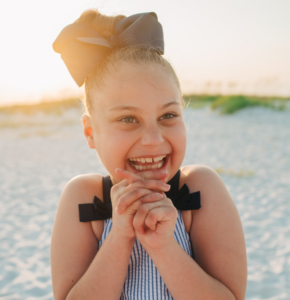
Meet Marley
When Marley was a baby, feeding challenges and growth concerns marked the beginning of her medical journey. She began facing developmental delays, leading to a diagnosis of failure to thrive and global developmental delays. Genetic testing in 2016 yielded no answers, as the NARS1 gene was not known to cause symptoms until 2020. Marley’s formal diagnosis came at the age of nine and a half, revealing she has NARS1 disorder, a nano-rare condition affecting fewer than 100 individuals worldwide. We were fortunate to find the Rory Belle Foundation, which is devoted to families affected by NARS1. Without the Rory Belle Foundation, we wouldn’t have known that this disorder causes cognitive, physical, and neurological issues, including progressive peripheral neuropathy, what research and drugs (like n-Lorem) could work, and that Marley, and we, have a community.
Marley’s biggest challenges include conversational speech, mobility challenges, due to neuropathy and low muscle tone, and navigating developmental hurdles, but her resilience shines through. She works so hard in therapies like OT, PT, speech, and ABA continuing to make progress despite her diagnosis. Marley’s newest adventure is RPM therapy (Rapid Prompting Method). It’s a way to communicate for non-speakers and unreliable speakers using letter boards, typing, and handwriting. RPM presumes competence in every student. Through this technique we are learning Marley knows how to spell complex words, can rhyme, loves poems and even knows how to do math, including multiplication. Recently when asked what her favorite thing is about herself, she spelled, “my hair.” Her parents agree!👍
Today, Marley’s loved ones are hopeful for the future where a personalized treatment will help her overcome the burden of her condition, allowing her to fully embrace her vibrant and joyful self and live her very best life possible.
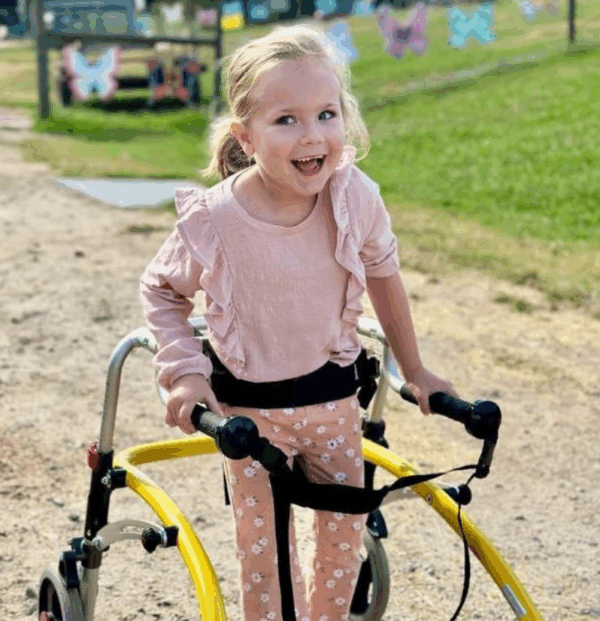
Meet Colbie
Colbie’s Story: The Search for Answers
At 17½ months old, Colbie’s family received a life-changing call: after months of testing and therapies, her delays and vision concerns were linked to an ultra-rare, progressive neurological disorder called KIF1A Associated Neurological Disorder (KAND).
The diagnosis was the heartbreaking answer to several unresolved questions; from vision and balance concerns to evaluations for hypotonia, seizures, and developmental delays. Despite her challenges, Colbie continued to grow and learn with the help of therapy, even as her parents sensed something more complex was unfolding. Whole exome sequencing confirmed their instincts, revealing a rare variation in the KIF1A gene.
KAND has a wide spectrum of outcomes. While Colbie continues to make progress in some areas, her future remains uncertain. She faces the possibility of increased spasticity, vision loss, seizures, and a lifelong need for assistive devices and therapies, amongst other challenges.
Through every unknown, one thing has remained constant: Colbie’s strength and her family’s fierce love and advocacy. Their journey has been marked by heartbreak, hope, and a deep commitment to giving her the happiest life possible.
Colbie Today
Now several years past her diagnosis, Colbie continues to meet challenges that most children never have to face. She has global developmental delays impacting her both cognitively and physically. At school, she uses both her walker and wheelchair with growing confidence. She attends 4 therapies a week, takes preventative medication for epilepsy and manages ongoing vision and fine motor challenges.
Yet none of this dims her spirit. Whether making her siblings laugh, soaking up one-on-one time, or giving her all in therapy, Colbie approaches life with joy, grit, and an unstoppable will to keep moving forward. KIF1A may shape parts of her journey, but it doesn’t define her. Her light shines through in everything she does.
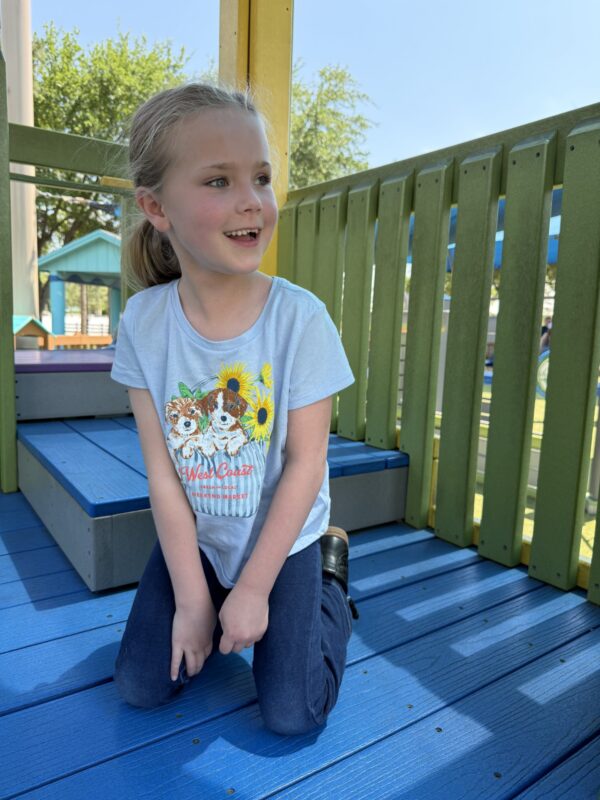
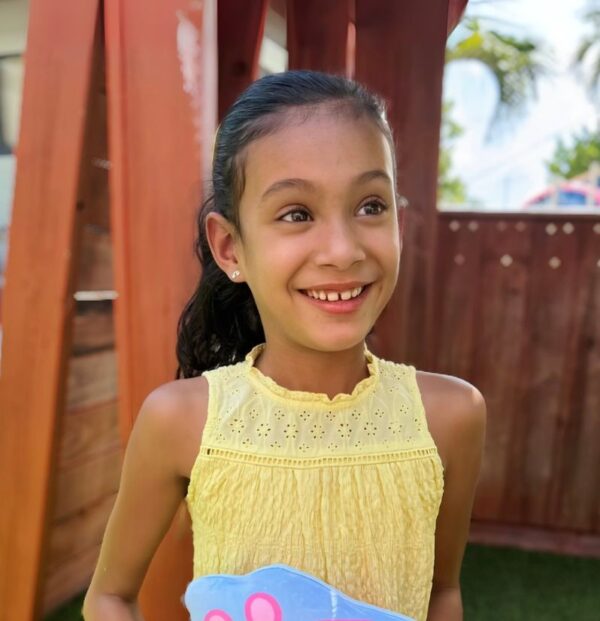
Meet Anais
Anais was born a seemingly healthy baby. Nothing about the pregnancy or her birth appeared out of the norm. However, as the months went on, it became clear that she was not meeting developmental milestones. She didn’t crawl until she was one, didn’t walk until she was two, and still struggles with her gait. Although she said her first words on time, she gained very few and lost them all by age four. Initially, her pediatrician was not overly concerned, so her family sought out a developmental pediatrician.
At the age of two, Anais was diagnosed with Autism and Global Developmental Delay. Genetic testing was conducted at that time, but a full genetic panel was not run. As a result, her HNRNPH2 genetic disorder was not discovered until she was six years old, when a new neurologist recommended whole exome sequencing. In the meantime, her family was left without answers as Anais continued to experience regression in skills, self-injurious behavior, severe anxiety, and a seizure that led to hospitalization.
This journey with Anais has been filled with fear and worry about her future, but her perseverance, radiant smile, and endless requests for hugs and kisses serve as daily reminders to stay positive and hopeful.
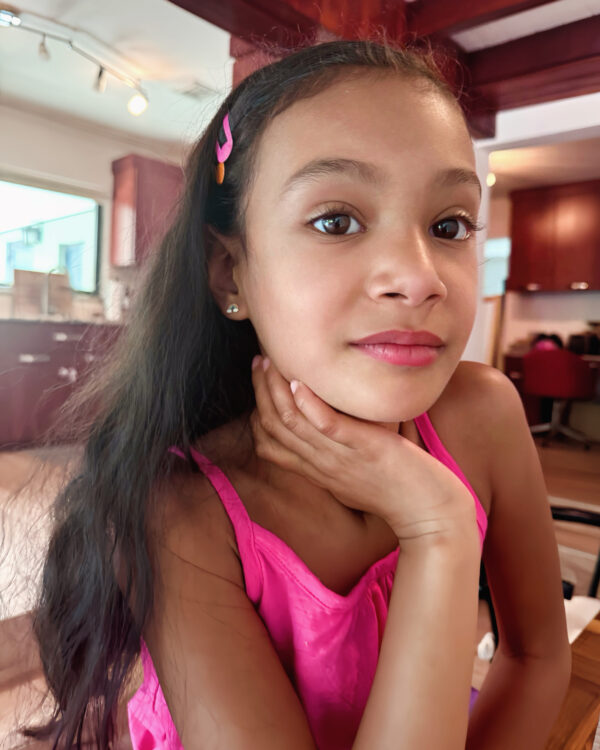
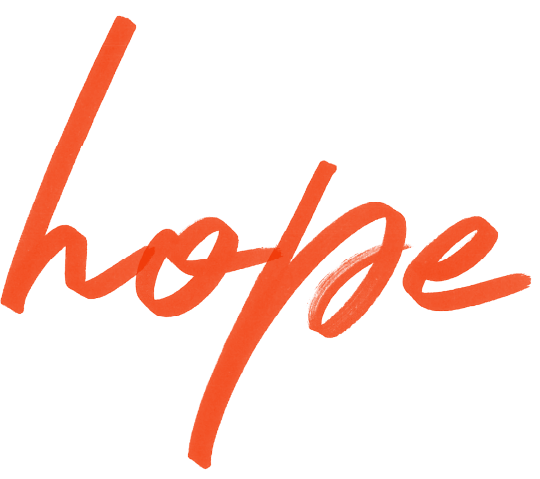






We welcome your family
to our community
We understand that being nano-rare often means that each patient is alone in their unique disease, alone in their suffering and isolated from the healthcare community. We want to change this by empowering our nano-rare patients.
The Patient’s Journey
Developing a personalized ASO treatment plan
At n-Lorem, our mission is to treat the patients we can today. By working closely with our research physicians and their institutions, we discover, develop and provide personalized experimental ASO medicines to nano-rare patients for free, for life. This journey begins with a research physician submitting an application to treat for their patient to n-Lorem.
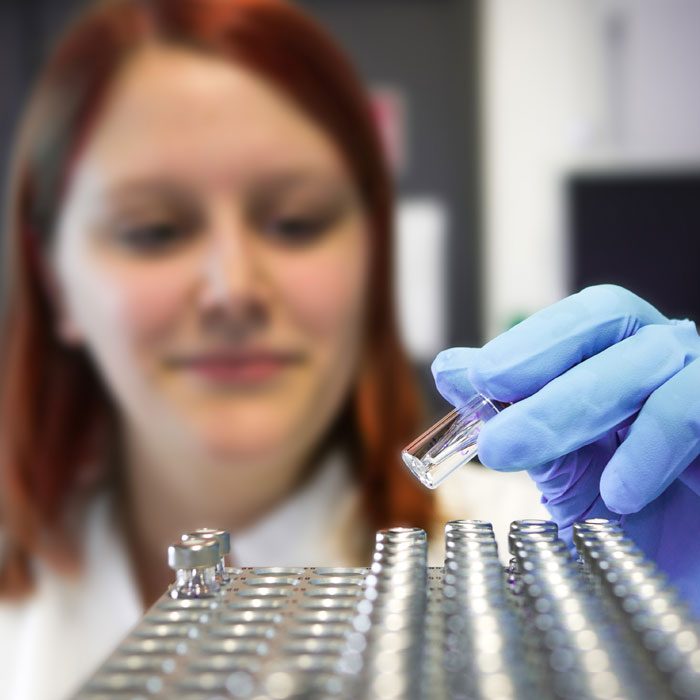
Find out if you
qualify for treatment
Nano-rare describes a patient that, because of their unique gene mutation, will be only 1 to 30 patients worldwide with that exact mutation. Most nano-rare patients have a single gene mutation that causes a cluster of symptoms that can affect their health. Many of these single gene mutations lead to degenerative conditions or even death.
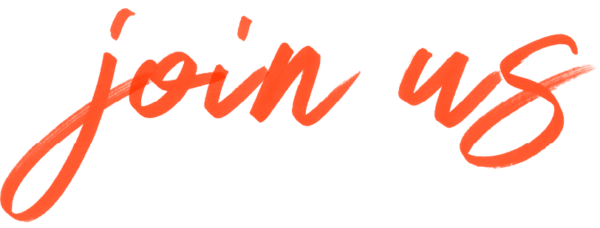
We cannot do
this alone
Together we are changing the world—
one patient at a time
We hope that you join us on this journey to discover, develop and provide individualized antisense medicines for free for life for nano-rare patients. The ultimate personalized medicine approach – for free, for life.

We need your support
